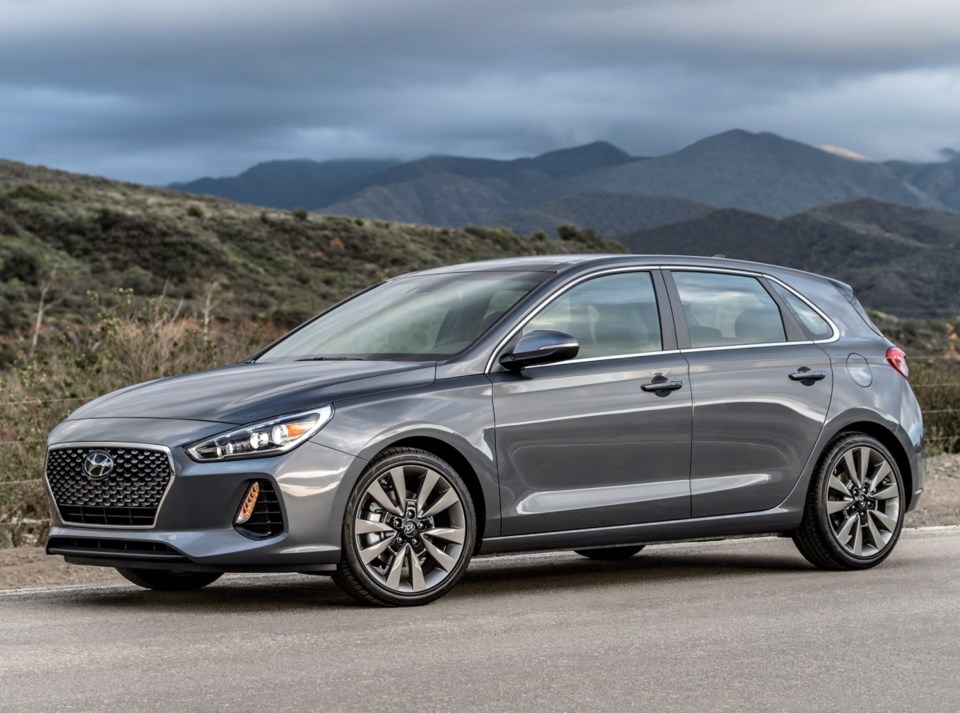If you’re going to spend money on a compact automobile, you might as well get one that maximizes both passenger and cargo space, like the Elantra GT hatchback does. That’s what an increasing number of buyers are going for as the popularity of hatchbacks continues to beat out the traditional small sedan.
This isn’t the Elantra’s first GT offshoot (the label was first used in 2013), but the 2018 model is the best. This GT is right on point in terms of styling, especially the protruding front end and octagonal grille. The rest of the design is straightforward and without superfluous bulges or creases to clutter things up. That’s not entirely unexpected, considering that German-born body-shaper extraordinaire Peter Schreyer penned a variety of Audi models prior to joining Hyundai-Kia in 2006. The GT originates from Hyundai’s factory in the Czech Republic and is known as the i30 throughout Europe.
Pasting a GT badge (the initials stand for Grand Touring) on a family-oriented hatchback doesn’t automatically turn it into a highfalutin’ cruiser, but in this case its use does correctly convey some sense of performance. The car’s aggressively lower stance and the widest possible distance between the front and rear axles stand out from the sedan.
Likewise, the GT’s tablet-style (non-integrated) touchscreen, stylish dashboard and sportier front seats are unique to the hatchback, although the Elantra Sport sedan does provide similarly formed buckets and gets a flat-bottom steering wheel that unfortunately is unavailable in the hatchback.
Unlike some small hatches, the GT’s sizable rear doors provide a wide-enough entryway to the split-folding bench. When the rear seat is left upright, the available stowage space is nearly double that of the Elantra sedan. When the seat is folded (nearly) flat, the GT crushes virtually every competitor in its class, including the Honda Civic, Mazda3 and Volkswagen Golf.
The GT also lays down some impressive powertrain choices, beginning with a 2.0-litre four-cylinder that makes 161 horsepower and 150 pound-feet of torque. For something punchier, an available turbocharged 1.6-litre four-cylinder — standard with the GT Sport — delivers 201 horsepower and 195 pound-feet of torque.
A six-speed manual transmission is standard with either engine, while a six-speed automatic is available with the 2.0 and a seven-speed paddle-shift automatic directs the turbo’s torque to the front wheels.
Another piece of goodness that comes with the Sport trim is a multi-link independent rear suspension that replaces the more rudimentary torsion-beam setup. The multi-link helps the GT soak up the bumps while making the car handle more securely on twisty roads.
From the driver’s perspective, the Sport makes the GT a more enjoyable experience. The car moves smartly off the line, remains relatively flat in the corners and possesses plenty of mid-range torque when accelerating onto freeways or when passing slower-moving traffic. There is some detectable lag as the turbo spools up, but it’s only a minor issue.
The 2.0 earns a fuel-consumption rating of 8.7 l/100 km in combined city/highway driving, which is slightly better than the turbo.
Putting yourself behind the wheel of a base Elantra GT requires $22,300. That includes air conditioning and a 20-centimetre touchscreen, plus the usual power-assisted accessories.
Moving up to the Sport will take an extra bite from your wallet, but it comes with the turbo engine plus a panoramic sunroof, dual-zone climate control, leather-covered seats (heated in front) and a multi-link rear suspension.
The Sport Ultimate piles on exclusive items such as a navigation system, ventilated power driver’s seat, Infinity-brand audio package and a host of active safety technologies designed to prevent collisions with other vehicles and pedestrians, or at least reduce their severity.
Ultimately, the slightly mislabelled GT holds its own among the hatchback pack and we have Peter Schreyer and Hyundai’s European-influenced powertrain and suspension tweaks to thank for that. The fact it also has loads of room begs the question: Why even look at a sedan?



